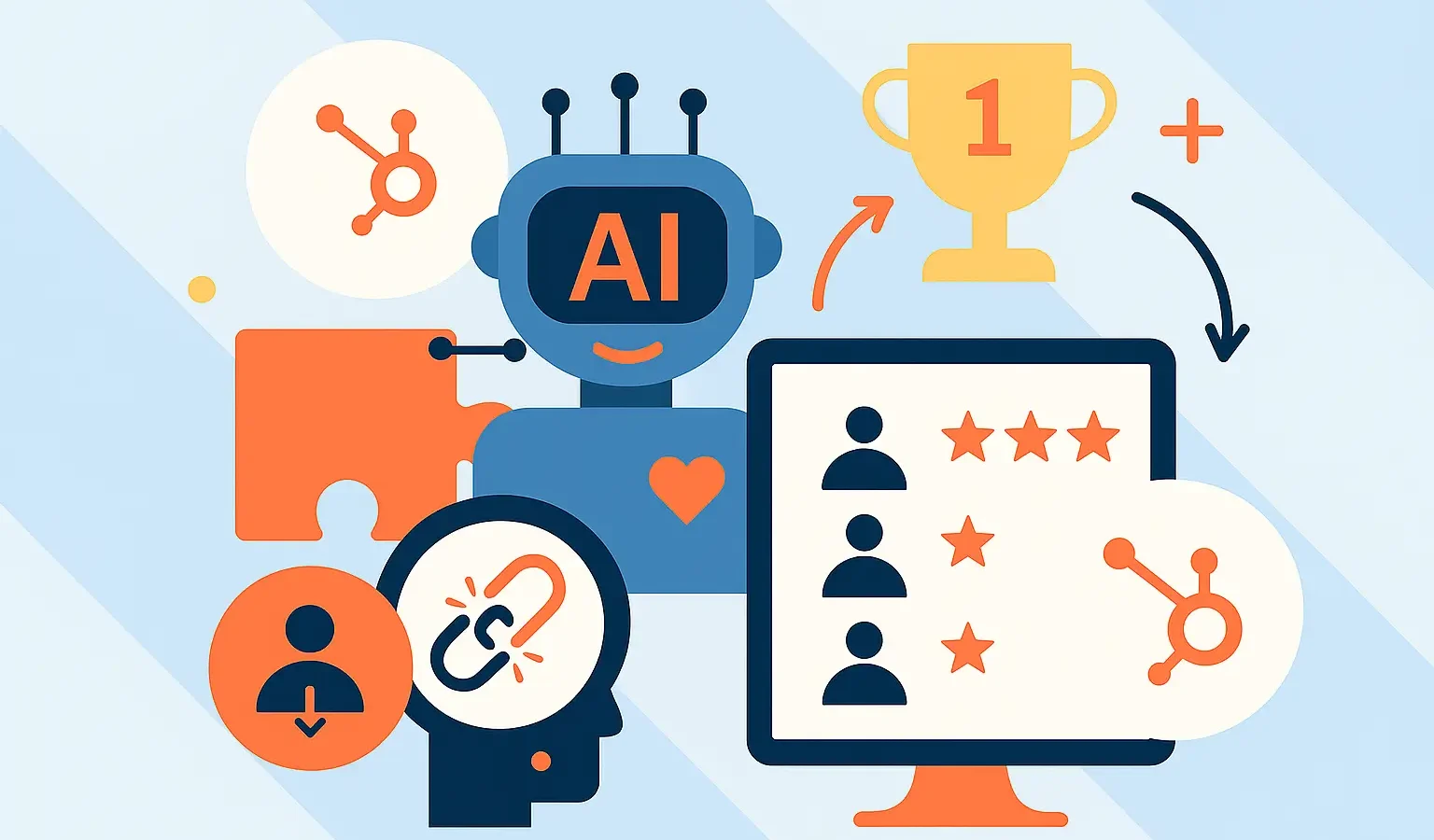Let’s be honest: traditional lead scoring is often just a group of people sitting in a conference room making educated guesses.
You decide that if a prospect clicks an email, they get 5 points. If they visit the pricing page, they get 10. If they download a whitepaper, you give them 20 points and hand them to sales.
But what if that prospect just really loves reading whitepapers and has zero budget? Meanwhile, a serious buyer visited your “About Us” page twice and got ignored because your arbitrary math said they weren’t interested.
Your sales team gets frustrated, marketing gets defensive, and your best leads slip through the cracks.
There is a better way. It’s time to stop playing guessing games with your revenue and let the data do the work.
Key Takeaways
- Manual scoring is obsolete: Guessing point values for clicks and views is inefficient, biased, and creates friction between sales and marketing.
- AI does the heavy lifting: HubSpot’s predictive models utilize machine learning to analyze historical data, determining what actually drives revenue rather than what you hope drives revenue.
- Data integration is the critical success factor: AI is only as smart as the data it consumes. Feeding your model operational data from outside HubSpot (like ERPs, proprietary apps, or event platforms) is the secret to high-fidelity scoring.
- Focus on “Work Smarter” workflows: Using AI allows sales teams to stop acting as data janitors and start acting as closers.
The Evolution: Why Manual Lead Scoring Fails
To understand why AI lead scoring in HubSpot is the solution, we have to look at why the manual method is broken.
Manual lead scoring relies entirely on human intuition. While we like to think we know exactly what a “buying signal” looks like, we are biased. We overvalue the actions we want people to take (like downloading an eBook) and undervalue the subtle signals that actually indicate intent.
The “Set It and Forget It” Trap
The biggest issue with manual scoring is maintenance. You set up your scoring criteria in 2021. But the market changed in 2022. Your product evolved in 2023. If you haven’t gone back and audited every single score property, your model is looking for a buyer that no longer exists.
Manual models are:
- Static: They don’t adapt automatically when buyer behavior shifts.
- Subjective: They rely on internal opinions rather than external proof.
- High Friction: They require constant meetings to “tweak the numbers.”
If you are tired of your sales team rolling their eyes when they get a “Marketing Qualified Lead” notification, it is time to retire the spreadsheet method.
Enter HubSpot AI: The “Work Smarter” Solution
HubSpot’s predictive lead scoring model changes the dynamic completely. Instead of you telling the system what is important, the system tells you.
This isn’t magic; it’s math. AI-powered scoring uses machine learning to analyze thousands of data points from your past customers. It looks at the contacts who actually closed (Closed-Won) and the ones who didn’t (Closed-Lost), and it works backward to find the patterns humans miss.
How It Works
The AI analyzes two distinct categories:
- Likelihood to Close: Based on behavioral data and firmographics, how probable is it that this contact will become a customer?
- Contact Priority: Relative to other leads currently in your pipeline, who should be called right now?
It might discover that your best customers rarely download your eBooks, but they almost always visit your “Security & Compliance” page. The AI sees that correlation immediately. You might not see it for months.
By using AI to automate sales lead prioritization, your team stops guessing. They wake up, look at their dashboard, and see a list of people who are statistically probable to buy.
The Secret Sauce: Why Integration is Critical
Here is the part most agencies won’t tell you, but we will because we value transparency.
AI is only as smart as the data you feed it.
If your HubSpot portal is an island, your AI is working with one hand tied behind its back. If HubSpot only knows about email clicks, form fills, and page views, the predictive model is limited to marketing data.
But your business is bigger than just marketing data. To really improve lead quality, the AI needs the full picture. This is where custom integration becomes your competitive advantage.
The “Garbage In, Garbage Out” Reality
Imagine you have a lead named “Acme Corp.”
- In HubSpot: They look cold. They haven’t opened an email in three weeks. Score: Low.
- In your SaaS App: They just added five new users and exported a report.
- In your ERP: They are up for contract renewal in 30 days.
If that external data isn’t inside HubSpot, the AI marks Acme Corp as “Cold.” Your sales rep ignores them. You lose the renewal.
However, if you use Integrate IQ to bridge those systems, HubSpot sees the app usage and the contract date. The AI instantly recalculates, flagging Acme Corp as a high-priority opportunity.
High-Value Data Signals to Integrate
To get the most out of predictive scoring, consider feeding these sources into HubSpot:
- Product Usage Data: How often are they logging in? Did they hit a usage limit? (This is a massive upsell signal).
- ERP / Financial Data: What is their total lifetime value? Do they pay on time?
- Event Data: Did they attend your booth at a trade show? (Scanned badges should flow directly into the scoring model).
- Help Desk Tickets: Are they submitting critical bugs? (Maybe don’t try to upsell them right now).
When you feed this contextual data into HubSpot, the AI doesn’t just predict marketing interest; it predicts business value.
Step-by-Step: Setting Up Predictive Scoring
Getting this running in HubSpot is straightforward, provided you have the Enterprise tier (where the real power lives) and a clean data foundation.
- Audit Your Data Hygiene
Before you turn on the AI, clean up your house. If you have duplicate contacts, bad email addresses, or inconsistent property values, the model will struggle to learn. AI amplifies your data, reality is good or bad. Ensuring you have structured data foundations is non-negotiable before activation.
- Activate Predictive Scoring
Navigate to your HubSpot settings. Under Objects > Leads > Lead Scoring, you will find the option to enable Predictive Scoring.
- Analyze the “Influential Factors”
Once the model runs (it usually takes up to 24 hours to process your historical data), HubSpot will present you with a report on Influential Factors.
- Positive Attributes: Things that increase likelihood to close (e.g., “CEO” job title, “Manufacturing” industry, “Clicked Pricing Page”).
- Negative Attributes: Things that decrease likelihood (e.g., “Student” job title, using a generic Gmail address).
Pro Tip: Review these factors with your sales leaders. It builds confidence in the system when they see the AI validating their own experiences.
- Build Your “Smart Lists”
Don’t just leave the score on the contact record. Make it actionable. Create Active Lists in HubSpot based on score tiers:
- Tier 1 (Score 90-100): Immediate Sales Outreach.
- Tier 2 (Score 70-89): Nurture High Priority.
- Tier 3 (Score 0-69): Marketing Nurture Only.
Making It Work: The “Smart Friend” Workflow
So, you have the score. Now what?
You need to translate that number into human action. We recommend the “Smart Friend” approach. The goal is to equip your sales team with context, not just a number.
The Old Way:
System Alert: “Contact Score is 95.” Sales Rep: “Okay… why?”
The Smart Way (with Integration):
System Alert: “Contact Score is 95. Increased priority driven by: Recent visit to Pricing Page + High Usage in App + 200+ Employees.”
When the rep sees why the score is high, they pick up the phone with confidence. They aren’t cold calling; they are consulting.
Frequently Asked Questions (They Ask, You Answer)
We know you probably have questions about handing the keys over to an algorithm. Here are the most common ones we hear.
Will AI lead scoring replace my sales team?
Absolutely not. AI is a compass, not the captain. It points your team in the right direction so they don’t waste time walking in circles. It automates the prioritization, not the relationship.
How much data do I really need?
HubSpot generally requires a minimum number of closed-won and closed-lost deals to train the model effectively. If you are a brand new startup with only five customers, stick to manual scoring for now. AI needs history to predict the future.
Can I still use manual scoring alongside AI?
Yes. HubSpot allows you to have custom score properties alongside the predictive score. This is useful if you have very specific business rules (e.g., “Always flag Fortune 500 companies”) that the AI might not weigh heavily enough on its own.
What if the AI gets it wrong?
It happens. The model improves over time. The best part about HubSpot’s tool is the feedback loop. As your team marks leads as unqualified, the model learns from that rejection and adjusts the algorithm for the next batch.
The Bottom Line
You didn’t hire smart, expensive sales talent to have them scroll through lists of 5,000 leads trying to find a needle in a haystack.
Moving to AI-powered scoring isn’t just about using a buzzword or being “cutting-edge” (a phrase we hate, by the way). It is about respecting your team’s time. It is about operational efficiency. And mostly, it is about making sure that when a perfect prospect raises their hand, you see it immediately.
But remember: The algorithm is only as good as the fuel you put in the tank.
Ready to get your data out of silos and into HubSpot so the AI can actually do its job?
Schedule a conversation with us. Let’s fix your data foundation so you can stop guessing and start closing.


